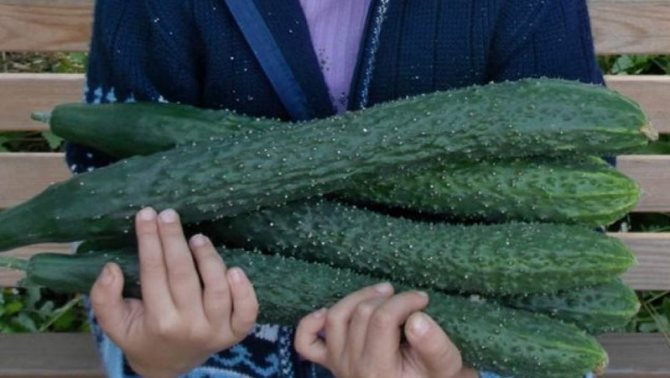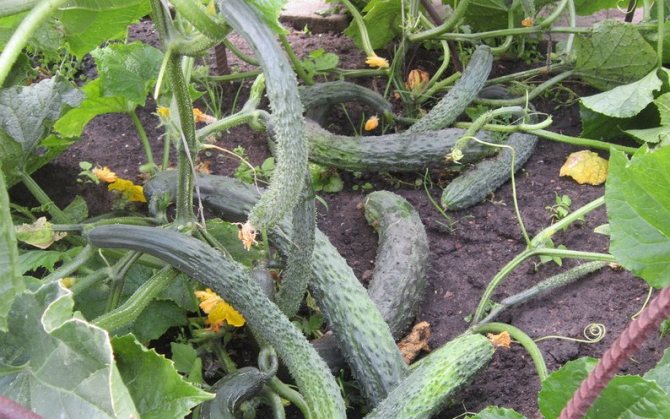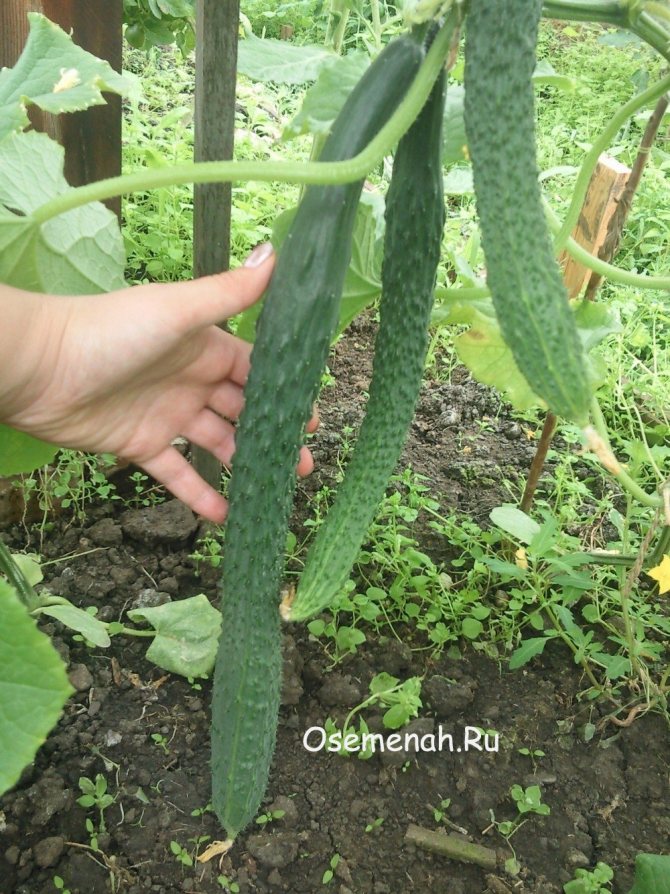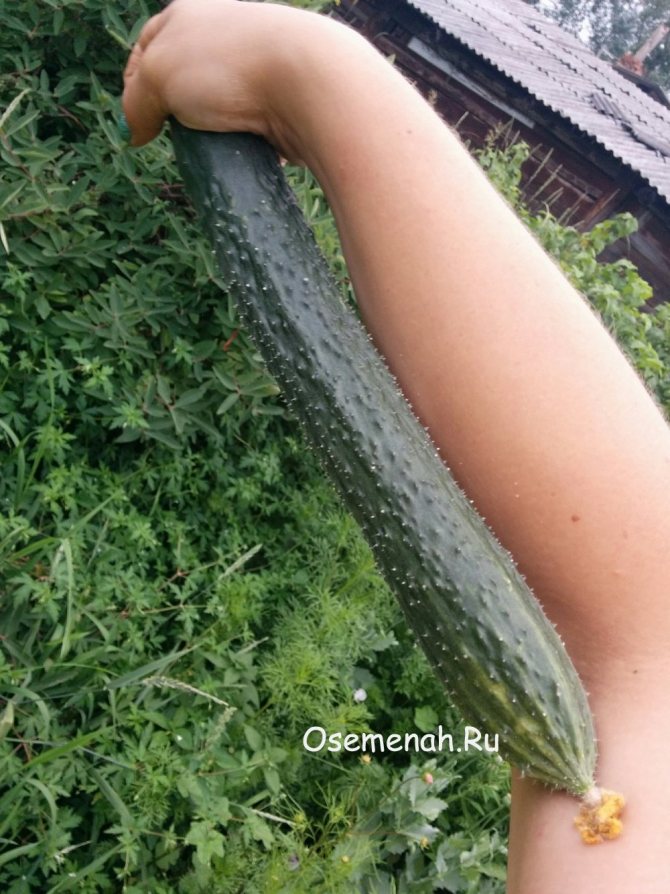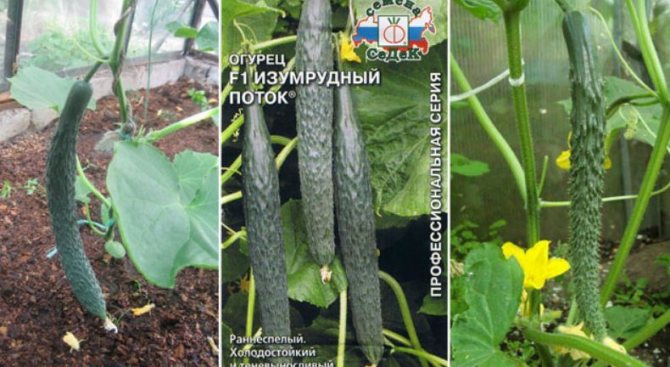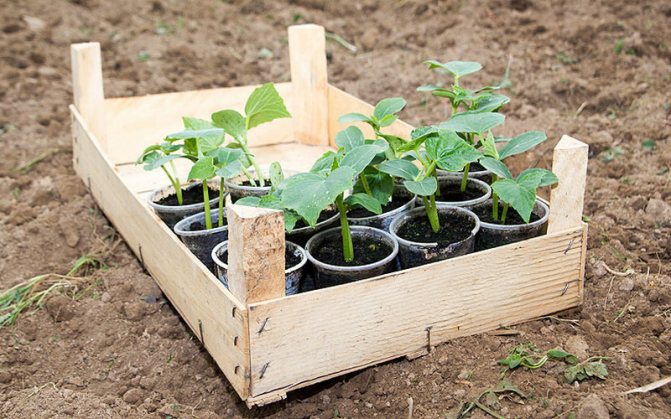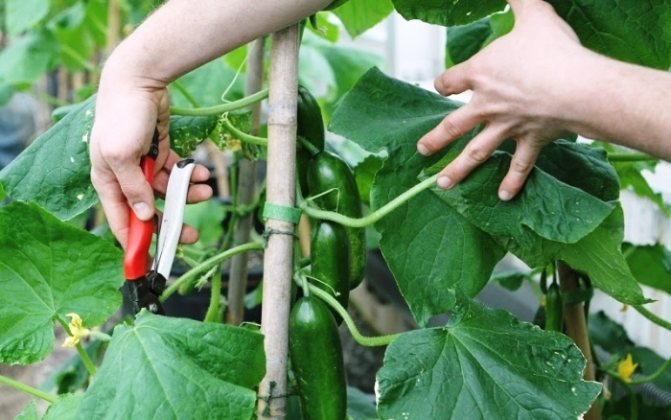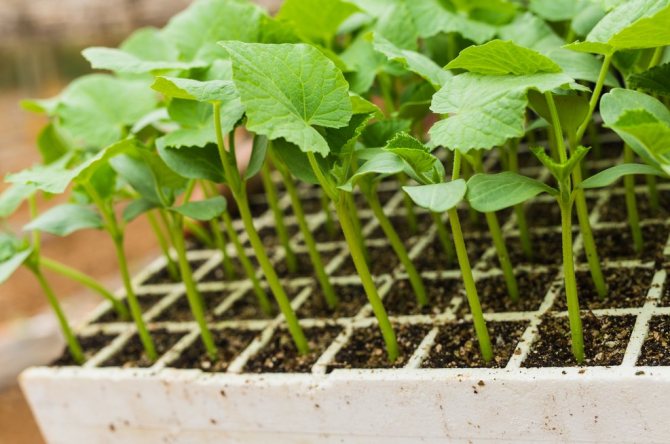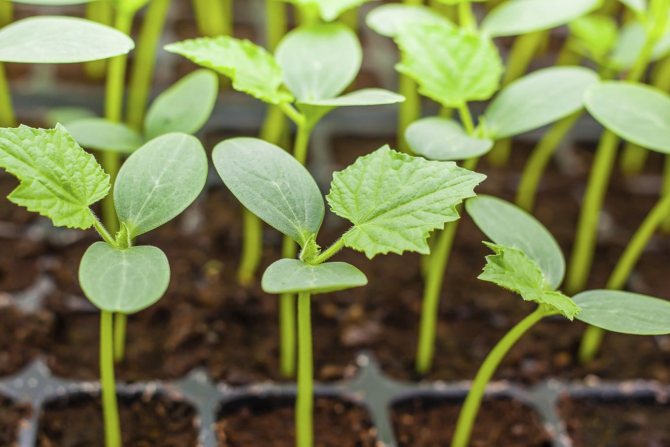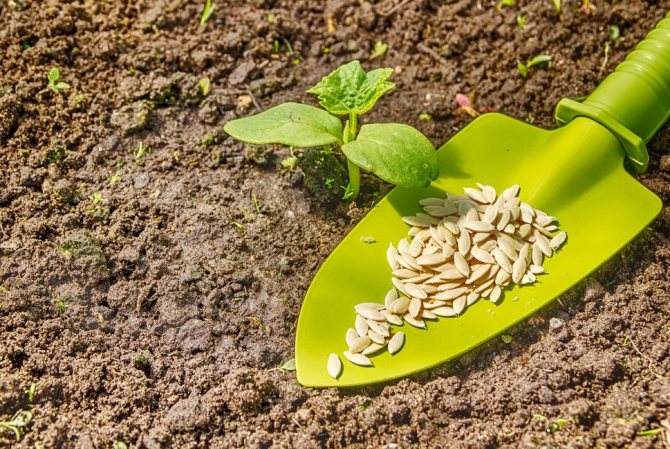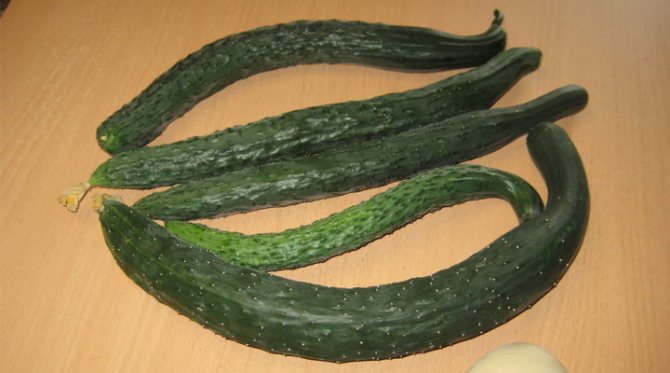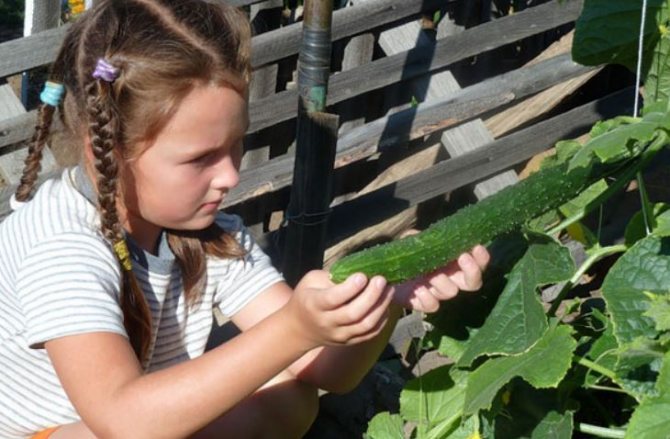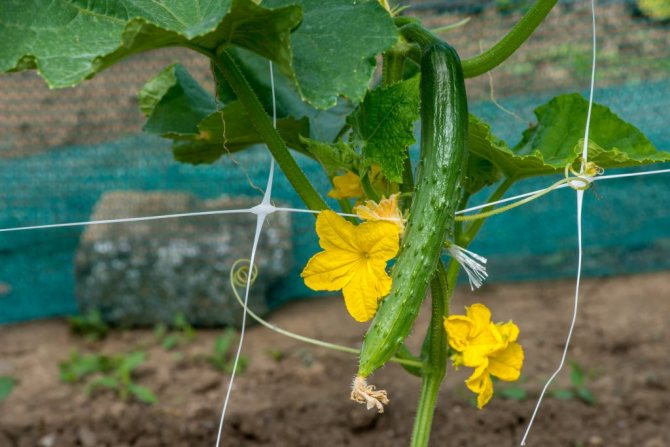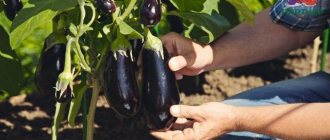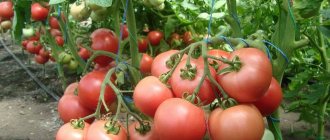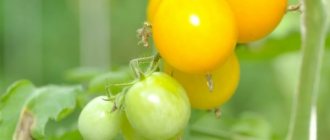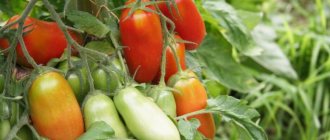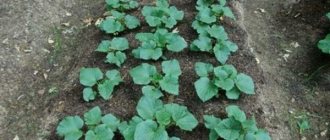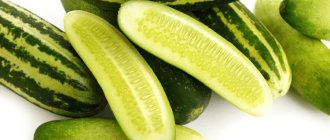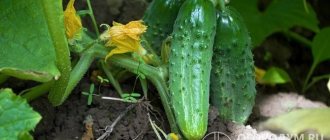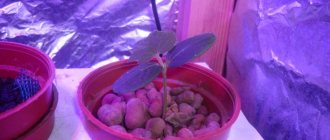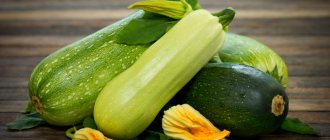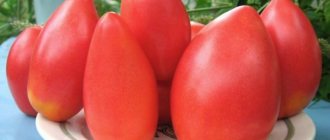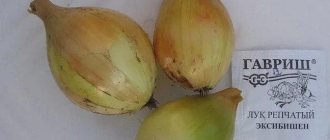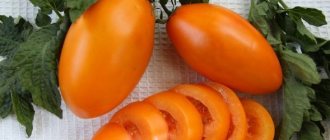Emerald Stream F1 is an early ripe hybrid of a salad-use cucumber. This hybrid fully justifies its name, since it bears abundantly for a long time with elongated-cylindrical greens with a delicate thin skin, sweet taste and excellent aroma.
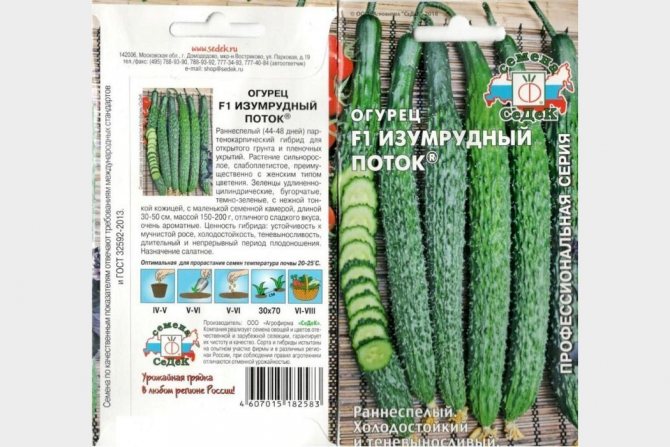
cucumber seeds "Emerald Stream"
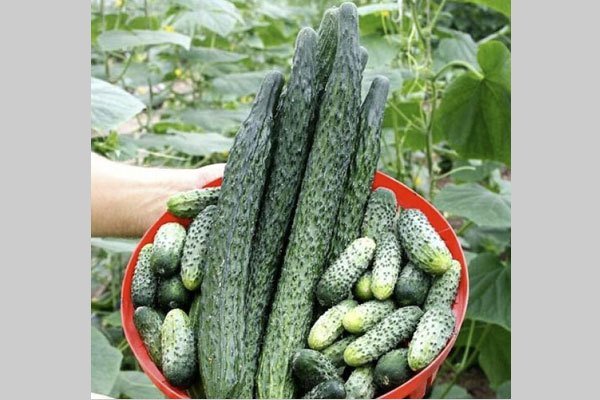

Ripe cucumber fruits "Emerald Stream"
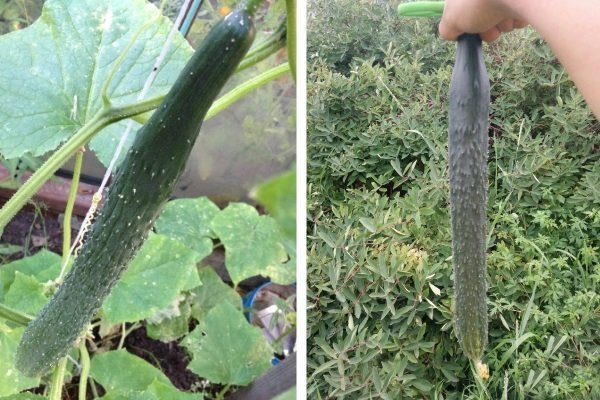

Emerald Stream cucumber can grow up to 50 cm in length
Description of Cucumbers Emerald Stream
The Emerald Stream variety is a hybrid of the first generation cucumbers, as indicated by the F1 prefix in the name. The description indicates that the culture was entered into the State Register in 2007. The seed producer is Russian agro, which occupies a leading position in the market.
Cucumbers are grown everywhere. In regions with a warm climate, the Emerald Stream is cultivated in the open field; for an early harvest, it is planted under a film. In places of harsh agriculture, where many crops bear fruit poorly, cucumbers of this variety are grown in greenhouses. It is for these reasons that summer residents are so fond of cucumbers.
The plant is medium-sized with moderate shoots, lateral lashes are long. They are often shortened in order to obtain a large harvest of cucumbers. The stems are powerful, the leaves and flowers are large. The first fruits are removed after 45-50 days.
In the catalog of the originator, the hybrid Emerald Stream is declared as a parthenocarpic cucumber. Initially, it was positioned as a bee-pollinated hybrid. Today, to get a good harvest, you do not need to wait for pollination by insects, the fruits are successfully tied without them, despite the weather.
Agronomists recommend growing the bushes of the Emerald Stream hybrid exclusively on trellises so that the fruits do not deteriorate.
Testimonials
Arkady
Emerald Stream is the perfect cucumber variety for making salads. The harvest ripens early, the cucumbers are large, very tasty. Our family grows this variety commercially. Due to their qualities, cucumbers are snapped up instantly. We ourselves not only feast on them, but also make rolls of various salads. I like this variety very much.
Natasha
I love the Emerald Stream very much. Despite the large size of cucumbers, we not only eat them, but also roll them up. I find this variety the tastiest compared to others. They are juicy, slightly sweet, without bitterness. The harvest grows amicable. Cucumbers, as for selection. Most importantly, they do not get sick and require minimal care.
Detailed description of the fruits
The Emerald Stream is often referred to as the Chinese Cucumber because of its size. Fruits are long - more than 20 cm, in a greenhouse they can grow up to 25 cm. They look thin, with a characteristic elongated neck, slightly ribbed. The color of the peel is dark green, at the stalk it is almost black.
The average weight of a cucumber of this variety reaches 150 g, sometimes it reaches 200 g, which is easy to achieve by applying fertilizing to the bushes during the growing period. The surface of the fruit is bumpy, with sparse thorns. The skin is thin and delicate. The flesh of the cucumber is moderately dense, juicy, crunchy. According to the reviews of summer residents who tried to preserve the fruits of this variety, these characteristics are preserved in salting.When you cut the zelenets Emerald Stream F1, you can see that the seed chamber of the cucumber is small. This is confirmed by photos and reviews of the variety. There are few grains, they are small. The taste of the fruit is excellent, with a pronounced sweet note. There is no bitterness at the genetic level.
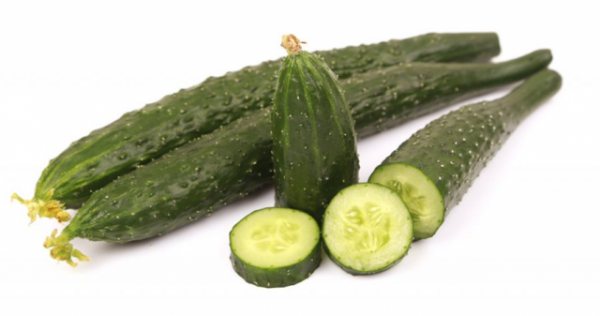

Cucumbers for salad
When choosing a variety for growing, gardeners, following a fashion or guided by other principles of selecting plants for beds, prefer pickling gherkins. However, those who love cucumber salad and are familiar with the cultivation of Chinese long-fruited cucumbers in their garden will always find a place for this variety.
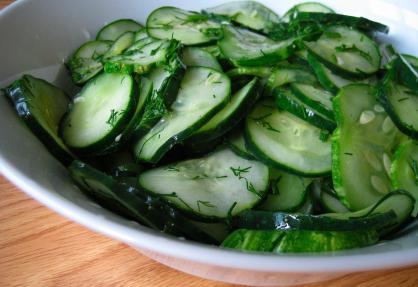

And it is not necessary to prescribe cucumber seeds from China. Reviews of happy owners of unusual vegetables are advised to grow domestic varieties and hybrids. Among them, the emerald stream cucumber variety has remarkable taste.
The main characteristics of the variety
According to the reviews of summer residents from different parts of Russia, we can conclude that the cucumber Emerald Stream F1 is quite hardy. Bushes equally well tolerate cold snaps, heat, scorching sun and shading in the greenhouse. Fruiting does not suffer from this.
Yield
When growing cucumber Emerald Stream in the greenhouse and in the open field, long and continuous fruiting was noted. The ovary appears until frost. On an open bed, the yield of the variety reaches 5-7 kg / sq. m. In the greenhouse, you can collect up to 15 kg / sq. m, but subject to all agrotechnical practices. Up to 4-5 fruits ripen on the bush at once.
Pest and disease resistance
The originator of the variety Emerald Stream claims that cucumbers are highly resistant to major diseases, including powdery mildew. Culture resists well:
- cucumber mosaic;
- anthracnose;
- cladosporium disease;
- bacterial rot.
However, moderate resistance to viral wilting was noted.
In general, Emerald Stream cucumbers rarely get sick. Reviews of summer residents about cucumbers confirm that this is practically the only hybrid that does not have to be sprayed often. If you create all the conditions for growing, then the plant does not care about pests.
Pros and cons of the variety
This is a truly tenacious hybrid that bears fruit stably in difficult conditions. It has many advantages and only one disadvantage.
Among the positive characteristics are:
- stable yield;
- high resistance to diseases and pests;
- ability to withstand heat and cold;
- long fruiting period;
- early return of the crop;
- undemanding care.
The disadvantages include only poor keeping quality of fruits. The description says that they do not remain fresh for long. Cucumbers are used for salad. But this is debatable. Many summer residents have already tried to preserve the Emerald Stream hybrid, and the variety has shown good results.
Pros and cons
Emerald Stream F1 is a cucumber hybrid that offers the following benefits:
- is a weakly growing female type plant with strong vigor;
- it is distinguished by continuous fruiting and high productivity (5-7 kg of fruits per 1 sq. m);
- tolerates a lack of lighting, unfavorable climatic and seasonal conditions, when the work of pollinating insects is difficult;
- does not take time for the seeds to ripen, therefore the fruits do not turn yellow, and throughout the growing season they retain an attractive appearance and excellent taste.
As for the disadvantages of this hybrid, it can be noted that it is susceptible to root rot. Gardeners also note that the presentation of cucumbers can be spoiled by their physiology. The fact is that the fruits sometimes turn out to be too long, so they begin to curl and bend into an arc.
Cucumber Emerald Stream is a tenacious hybrid of lettuce type, which bears fruit abundantly even in those conditions in which other varieties are either affected by cold and disease, or have already finished bearing fruit.At the same time, the plant in the garden is unpretentious, although it requires compliance with the rules of agricultural technology.
0
Growing Cucumbers Emerald Stream
Emerald Stream - cucumbers that are grown through seedlings at home, and only then transferred to a permanent place in a greenhouse or garden. Correct agricultural practices play an important role in this.
Sowing dates
Sowing of cucumbers begins in early spring. Timeframes may vary from region to region. Emerald Stream cucumber can be grown outdoors by sowing seeds directly into the soil. In the southern regions, already at the end of March or at the very beginning of April, they start planting under the film. In the central and northern part of Russia, this can be postponed until mid-May, until frosts pass.
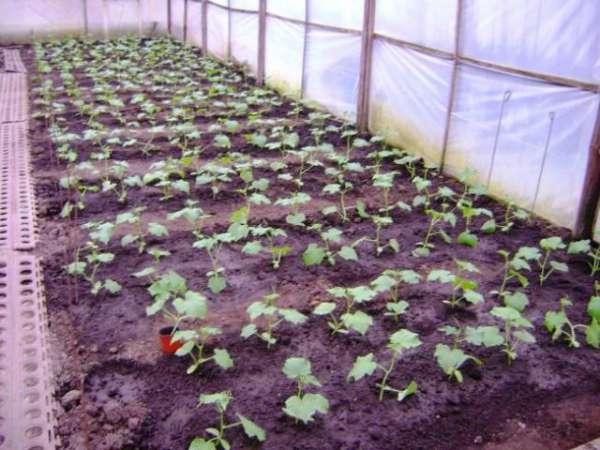

Growing seedlings is possible in a greenhouse, where in the future the bushes will grow. As a rule, sowing is carried out immediately when the ground warms up. Soil temperature should be at least + 15 ° С.
For seedlings, seeds of cucumbers Emerald Stream are planted 25-30 days before planting in the ground. During this time, the plants will gain strength and will be ready to be transplanted to a permanent place.
Site selection and preparation of beds
Emerald Stream is a variety of cucumbers that cannot be grown on acidic soil, as evidenced by reviews of this culture. Good results can only be achieved when grown in fertile soil. If the land is poor, then it must be enriched with mineral fertilizers with a high content of potassium, phosphorus and nitrogen.
A garden bed for cucumbers Emerald Stream is dug up in advance, before that fertilizers are applied. It is better to prepare the soil in the fall so that it has time to settle and absorb all the nutrients.
How to plant correctly
Seeds are planted in a trench manner. The depth of the furrow is no more than 5 cm. The distance between the seeds is about 15-20 cm. It is better to germinate them before sowing in order to get good germination. Seeds are covered to a depth of 2.5-3 cm.
Seedlings of Emerald Stream cucumbers are planted in shallow holes. The distance between them is no more than 20-25 cm. Each hole is filled with a mixture of ash and humus. After planting, the bushes are covered with foil so that the plants do not fall under return frosts.
Follow-up care for cucumbers
Agrotechnics of cucumbers Emerald Stream is simple:
- The soil must be loosened, but very carefully so as not to damage the root system. It is good if you can do this after each watering.
- The bushes are watered regularly, because cucumbers are a moisture-loving culture. Moisten the soil in the evenings, but water should not fall on the leaves or erode the soil at the roots.
- Fertilized cucumbers of the Emerald Stream variety throughout the growing season, because the lack of nutrients affects the yield. Mainly organic matter is introduced.
- The bushes form into a single stem, which is pinched when it reaches the top of the trellis.
According to the reviews of gardeners who grew cucumbers of the Emerald Stream variety, it is better to feed it 3-4 times. It is necessary to fertilize after the appearance of the first true leaf, so that the culture actively starts to grow, then after 3 weeks. The last feeding is done 14 days before harvest. Such a scheme is guaranteed to help you get a good harvest.
Agrotechnics
To get a good harvest of Emerald Stream, you need to be aware of the following basic agricultural practices:
- In the conditions of the northern regions, it is necessary to grow the culture with the help of seedlings, which can be transplanted to a permanent place in the phase of 3-4 true leaves. In the southern regions, you can also use seed planting, which implies sowing seeds directly into open ground.
- Sowing seedlings should be done in April-May, in order to transplant sprouts to a permanent place already in May-June. In open ground, seeds can be sown in May-June. Harmonious soil temperature for seed germination is + 20 ... + 25 ° C, and the air temperature is not less than + 18 ° C.In such conditions, the first crop can be harvested in June-August.
Cucumbers are very demanding on the air temperature, and if it drops below + 10 ° C, then they may stop growing altogether.
- The plant should not be heavily thickened so that the bushes can fully develop and bear fruit. So, in greenhouses, planting should be done at the rate of up to 3 plants per 1 sq. m, and on the street - up to 4-6 plants per 1 sq. m.
- For cucumbers, you need to choose sunny and wind-protected areas with fertile, light and loose soils, but acidic, heavy and waterlogged soils are contraindicated. The best predecessors of the hybrid are: early cabbage and cauliflower;
- tomatoes;
- onions and garlic (ideal predecessors, since they disinfect and saturate the soil with their phytoncides);
- beet;
- potatoes;
- peppers;
- greens;
- legumes (except for beans).
- late varieties of cabbage;
The cucumber should not be planted next to the beds where potatoes grow, since such an experiment will lead to diseases of the crop and slow down its development.
In the next video, the gardener shares his experience on how to grow a hybrid salad variety:
Cucumber emerald stream, plant description
Characteristics and description of the variety:
- The bushes are medium-sized.
- The arrangement of the ovaries is bunched.
- Medium type weave.
- The sheets are large.
- Disease-resistant.
- Frost resistant.
The fruits are long, weighing from 150 to 210 grams. The length of a young cucumber is from 15 to 20 cm, overripe - 50 centimeters. The inside of the vegetable is dense, crispy, fleshy flesh. The outer skin is covered with tubercles.
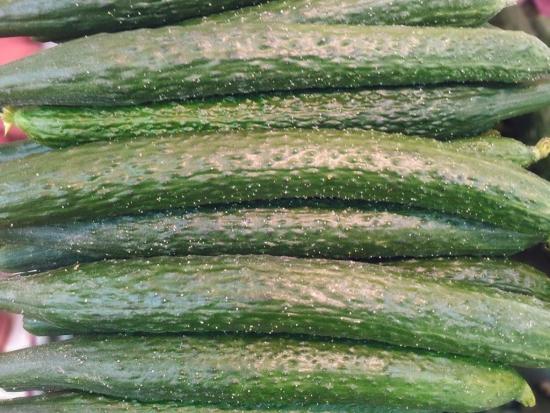

The taste is sweet, even without proper watering, the bitterness is absent.
On one bush, up to five fruits are immediately tied. The variety is early ripe, you can pick the first cucumbers on the fortieth day.
The main feature of the emerald variety is that insect pollination is not needed. Productivity will increase decent care.
Greenhouse cucumbers
High-quality planting material is planted in rows in closed ground. For the full development of the planting, you should not thicken it. They keep at least 50 cm between the seedlings. Particular attention should be paid to the soil. If cucumbers are grown for several years in a row in one place, which is highly undesirable, the soil composition of the greenhouse should be updated. It is filled with fresh fertile soil and a complex mineral fertilizer is applied. The soil should be loose and have excellent aerobic qualities.
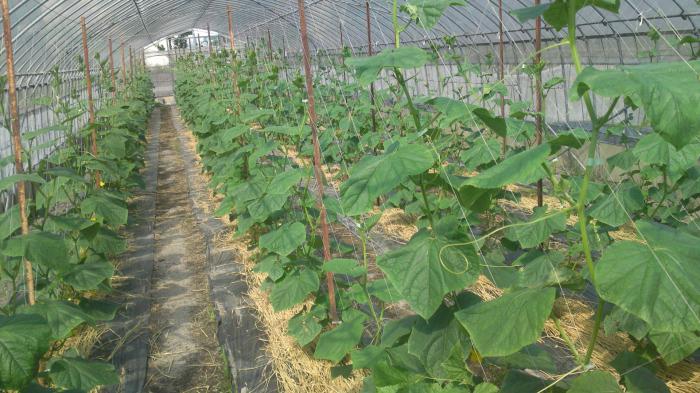

Greenhouse cucumbers are grown vertically. The "emerald stream" cucumber hybrid is characterized by increased growth with the formation of medium lashes. It is tied to the frame of the greenhouse.
Care rules
Here are some basic guidelines:
- During the growing season, fertilizer must be added to the soil. As a top dressing, organic matter is used, for example, rotted manure.
- If there is a lack of moisture in the mail, then in addition to organic matter, you still need to add lime or a solution of potassium permanganate.
Regularly water the greens with warm settled water in the evening. It is important that the water does not get on the foliage, otherwise it will turn yellow.
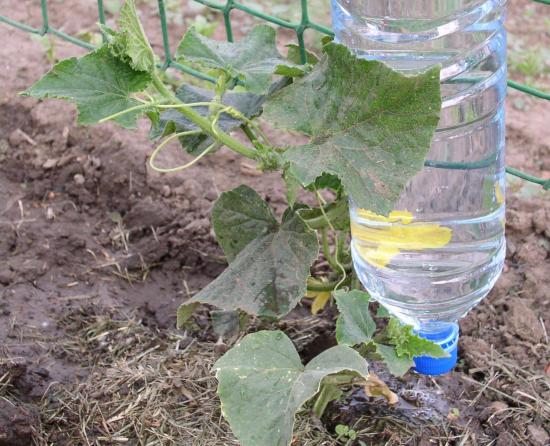

After watering, it is important to loosen the soil and remove all weeds.
If you follow these simple tips, the yield will increase several times.
Landing features
It is recommended to disinfect the seeds before planting. To do this, they are kept for 30 minutes in a weak solution of potassium permanganate. To speed up the emergence of the crop, the seeds can be germinated. To do this, they are placed in a damp linen cloth, which is placed in a warm place.As soon as sprouts appear, the seeds can be planted in the ground.
In the beds, grooves are made or holes are dug, the depth of which should be about 3-5 cm. Planting is carried out in such a way that the distance between each plant is 20 cm. The cucumbers are watered and covered with foil. The film is then removed only in the daytime, when 3-4 true leaves appear on the plants. The film is completely removed in early July.
No more than 3-4 plants should be sown on one square.
How to shape the stem
The emerald cultivar has few side shoots, so it is important to get the right stem shaping.
When the sixth leaf is formed on the boring, you need to cut off all the stepsons and ovaries.
After a while, you need to cut off the stepsons, but leave one ovary every three leaves.
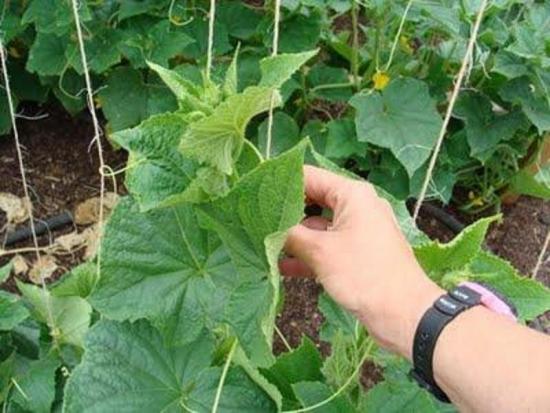

It is equally important that the bush grows vertically; for this, tying is carried out. Ideally, plant cucumbers along the fence. If this is not possible, then it is worth building a trellis from wooden planks or pulling a mesh.
Mesh and trellis are suitable for greenhouses as well as for open ground.
Optimal growing conditions
Emerald Stream cucumbers are grown in seedlings. Seedlings of Emerald Stream cucumbers take root in the house, then they are planted in a greenhouse or on an open ground.
For full growth, cucumbers need temperature control. This concerns the warming up of the soil. So, cucumbers are not planted if the soil does not warm up to at least +15 ° C.
For cucumbers, areas are chosen that are illuminated by the sun in the morning and afternoon hours. They should be removed from the places where there is the occurrence of through winds.
To prevent the lashes from spreading along the ground, trellis supports or additional supports are used to grow them. The scourge is tied up as needed. The fruits are harvested in a timely manner so that the plant has the opportunity to form new ones.
Diseases and pests
This type of cucumber is disease-resistant, therefore it is not attacked by pests and does not get sick.
Experienced gardeners carry out preventive manipulations:
- observe the irrigation regime;
- foliage is sprayed with a weak solution of iodine and hydrogen peroxide;
- inspect stems and foliage, removing damaged ones;
- vegetables are planted along with calendula and marigolds, these flowers repel pests and insects.
These manipulations strengthen the flower's immunity and make it stronger.
Productivity, fruit harvesting, storage
The average yield per square meter is 6 kg.


Pickled cucumbers immediately after ripening. Crispy and juicy fruits are considered, the size of which is no more than 30 cm.
It is impossible to save this vegetable for a long time, it quickly deteriorates and becomes soft, not suitable for transportation.
After collecting, you can put the greens in the refrigerator for no more than three days.
Harvesting and storage
Cucumbers should be picked as they ripen. Often such work is carried out daily or every other day. The fruits will need to be carefully cut without damaging their ovaries. The optimal length for cucumbers is 25-30 cm, although they can grow up to half a meter.
The harvested crop should be stored in a cool, ventilated area. If the fruits were cut before they reached 50 cm, they are not suitable for long-term storage, as they quickly become soft. To keep such cucumbers for 2-3 days, they should be kept in the refrigerator in a bag and washed immediately before use.
How to harvest in a greenhouse is described in the following video:
How to grow an emerald flow cucumber on the balcony
This variety grows very well on the balcony.
Initially, you need to prepare the seed. For this, seeds are soaked in early April. In a few days, borings will appear, at which time the seeds need to be transplanted into disposable cups.
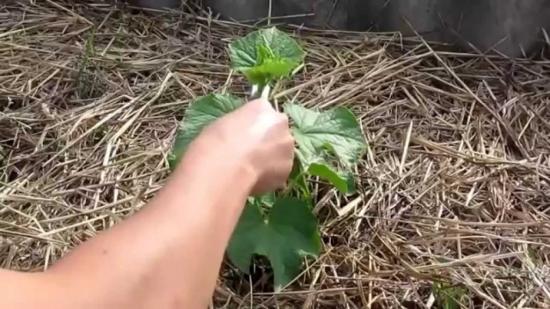

Planting depth - half a centimeter.After 21 days, the first leaves will hatch, now you can transplant the seedlings to a permanent place.
Let's watch a video on how to grow cucumber seedlings:
It is important to choose the right place for the plants.
Cucumbers love warmth, so they should be grown on a windowsill that is located in the west or south. Avoid drafts.
It is necessary to calculate the space. It is important to leave at least 30 cm for one stem; no more than 5 bushes can be placed on the windowsill.
Flower pots or wooden boxes can be used as containers. In containers, it is imperative to make drainage holes for water. Pebbles or expanded clay are poured at the bottom, they filter and oxygenate the root system.
Main conclusions
Emerald Stream has a delicate texture and amazing taste. Also, the variety is distinguished by high fruiting and 100% germination. But, like any varietal crop, this variety requires care. It is important to carry out the following activities:
- land on time;
- weeding;
- feed plants;
- tie up the bushes.
If cucumbers are grown in the same place for several years, they lose their varietal qualities. Therefore, it is recommended to plant them in new places every year.
Cucumber emerald stream f1, reviews, what are the advantages and disadvantages of the variety
- disease resistance;
- excellent taste;
- high productivity;
- frost resistance.
- the root system is prone to rot;
- short shelf life of fruits.
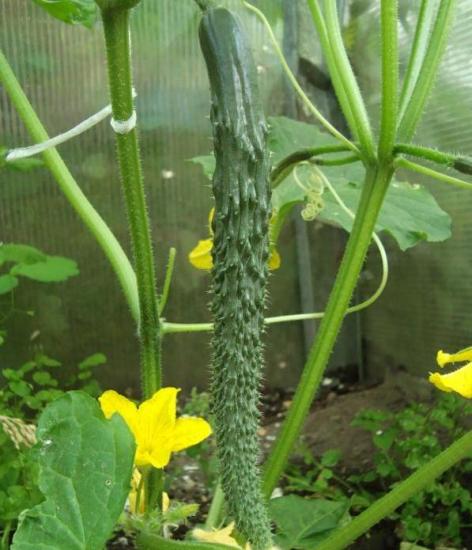

You can find different reviews about Emerald Stream cucumbers, because it is not for nothing that they say: it is difficult to find a friend for the taste and color of a friend. Let's get acquainted with the comments of summer residents who have already managed to get the harvest.
Sinetskaya Julia: I have never had such tasty and fruitful cucumbers, I recommend to everyone! Suitable for those who like to eat fresh vegetables. The peel is thin, there is no bitterness. I grow cucumbers in a greenhouse, the ovaries are formed continuously, they bear fruit for a long time, there are no barren flowers. They do not require special care.
Khorba Anatoly: I didn't really like the Emerald Stream. Long cucumbers are suitable for exotic gardeners. Vegetables are too watery and sweet. If not eaten within 24 hours, they immediately become flabby and soft.
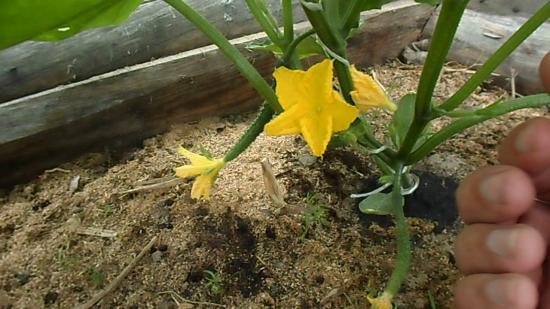

Belenkaya Valeria: I do not agree that this variety is not suitable for canning. Last year the harvest was so great that I decided to roll up small cucumbers. I used the usual recipe for this. As a result, the cucumbers are crispy and delicious.
Another review of the emerald stream f1 cucumber variety is on video:
So, the Emerald Stream cucumber is an unusual but very prolific variety.
For those who like to eat fresh salads, this is an ideal option.
This species does not require special agrotechnical skills, so even beginners can plant it.
A hybrid of cucumbers "Emerald Stream F1" was bred by Russian agro breeders (Moscow region, Domodedovo), patented and entered into the State Register in 2007. Recommended for growing in all regions of Russia in personal subsidiary plots (in the open field and under film shelters).
Many attribute this hybrid to a variety of the so-called Chinese cucumbers - long-fruited, salad purposes. "Emerald Stream F1" is distinguished by a long period of continuous fruiting (in spring-summer and summer-autumn rotation), high yield, good taste of fresh cucumbers.
Direct sowing of seeds into the ground
With seed growing, work is carried out in the second decade of April or early May, when the threat of spring frosts has completely passed. It is advisable that the temperature for 2-3 days at night does not drop below + 12 ° C, and in the daytime - not below 20 ° C. When sowing a cucumber in a greenhouse, which is also heated, this condition can be considered very conditional.
At the optimum time, sowing work is carried out in the following order:
- Dry the treated seeds until they flow.
- In moist, but not waterlogged soil, prepare grooves at a distance of 15-20 cm from each other. The optimum row spacing is 70 cm.
- Deepen the seeds by 2-4 cm and carefully cover them with the nutrient mixture so as not to damage the hatched sprouts.
- So that the soil on the site does not dry out, it should be covered with a film. This will also help protect crops from sudden temperature changes or spring frosts.
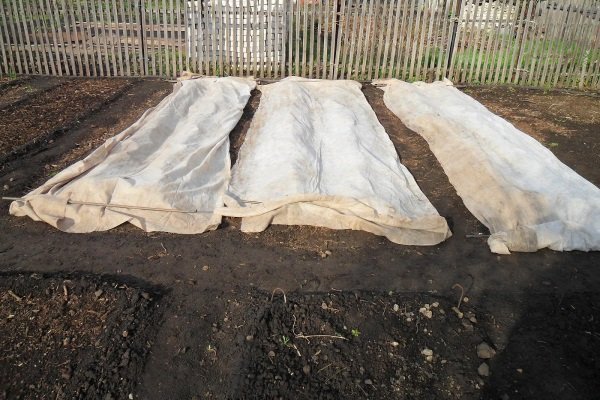

Sawdust or pine needles can be scattered around the planting site to scare away the bear.
Main characteristics
Among the advantages of the hybrid should be noted:
The variety was originally declared as bee-pollinated, but today in the catalog of the agro (originator) it is referred to as parthenocarpic. This suggests that the greens will be poured safely even in the absence of insects, but it is believed that their help in additional pollination increases the yield.
The plant is vigorous and weakly plaited, with a predominantly female type of flowering and powerful strong lashes, capable of withstanding the simultaneous filling of up to 5 fruits. The impressive size of the plant, which requires abundant watering and regular feeding, is especially important to consider if you want to plant this hybrid at home on the windowsill. It is recommended to grow vertically (by tying to a trellis or net) and the formation of plants (by pinching the central stem after it reaches the top of the trellis, and lateral shoots - behind the 2-3rd leaf).
"Emerald Stream F1" refers to the early maturing: the first harvest is formed depending on the growing conditions on the 40-48th day after full germination. One of the most valuable qualities of a hybrid is considered its long-term (until frost), consistently high and continuous fruiting. Marketable yield is 5-7 kg / m 2 in open ground, and in greenhouse conditions, subject to agrotechnical requirements, it can be much higher.
Zelentsy are long (on average 20-25 cm, weighing 150-200 g), thin, slightly ribbed, have an elongated cylindrical shape with a long neck and dark green (almost black at the base of the peduncle) color. The skin is tender and thin, covered with small tubercles and medium-dense white pubescence (thorns). The pulp is quite dense with a small seed chamber inside, juicy, crunchy, has an excellent sweet taste (there is no bitterness at the genetic level) and a pronounced aroma. The purpose of zelents is primarily salad. They are recommended to be removed at a length of 18-25 cm, since overgrown fruits (over 45 cm) begin to thicken and turn yellow, which leads to a deterioration in taste.
Among the advantages of this hybrid, its unpretentiousness is noted, namely:
- powdery mildew resistance;
- shade tolerance and cold resistance, relative drought tolerance;
- less than other cucumbers, the propensity to be damaged by pests (aphids, spider mites).
According to numerous reviews, "Emerald Stream F1" is characterized as a very tenacious cucumber, capable of bearing fruit longer and more stable than others under unfavorable conditions. As disadvantages, we can note the susceptibility to root rot and the short keeping quality of the fruits.
Svetlana Kuznetsova, 46 years old, Saransk
I plant only Chinese cucumbers for salads - long and sweet. In recent years, I stopped at the Emerald Stream F1 hybrid. Unpretentious and powerful plants, I plant seedlings in open ground and pull a net for them. For our whole family, 2-3 bushes are enough. We eat cucumbers all summer. One can cut into a large bowl of vegetable salad. They are so sweet and juicy that they perfectly quench thirst in the heat. Sometimes I make lightly salted - it also turns out delicious, but for preservation I still prefer other varieties - small gherkins (Rodnichok, Connie, Murashka).
Yulia Sinetskaya, 64 years old, Tosno
I recommend the "Emerald Stream F1" variety to everyone.We have never had such fruitful and sweet cucumbers! More suitable for those who just like to crunch a fresh cucumber. They are not suitable for salting and pickling. Very tasty in themselves, delicate and aromatic. The skin is thin, the seeds are small, not bitter at all. We grow in a greenhouse (Leningrad region), bear fruit for a long time and continuously, despite our rather harsh conditions. We pluck cucumbers every day, until they are overgrown, and new ovaries appear immediately. They give few barren flowers. They are not capricious in leaving.
Anatoly Khorba, 51 years old, Tver
As for me, all these long cucumbers, such as the Emerald Stream, are more for exotic lovers. Too sweet, watery, and if they lie down for even a day, they immediately soften, sag and become “cottony” at the base.
Daria Istrenko, 39 years old, Tambov
Some of the hardiest cucumbers in the open field near Tambov were Krepysh, which was planted for winter harvesting, and Emerald Stream - for food. Stream has everything just huge: bushes, leaves and the cucumbers themselves. They ate them constantly, even when everyone else was sick or had already finished bearing fruit. The largest cucumbers grew up to 40 centimeters, but we mostly shot them before, 20-22 cm long. We really liked the taste and yield.
Valeria Belenkaya, 45 years old, Kharkov
I disagree with those who consider Chinese cucumbers unsuitable for canning. Last season I got a big harvest of the Emerald Stream F1 cucumber variety. I shot small, thin cucumbers, put them vertically in liter jars and poured marinade according to the usual recipe. It turned out very tasty and crispy!
An interesting way to grow a hybrid variety in a greenhouse can be found in the following video:
For several years she worked as a TV program editor with leading producers of ornamental plants in Ukraine. At the dacha, of all types of agricultural work, he prefers harvesting, but for the sake of this she is ready to regularly weed, pick, pinch, water, tie, thin out, etc. I am convinced that the most delicious vegetables and fruits are grown by your own hands!
Found a bug? Select the text with the mouse and click:
It is necessary to collect medicinal flowers and inflorescences at the very beginning of the flowering period, when the content of nutrients in them is as high as possible. Flowers are supposed to be picked with hands, breaking off rough pedicels. The collected flowers and herbs are dried, scattered in a thin layer, in a cool room at a natural temperature without access to direct sunlight.
"Frost-resistant" varieties of garden strawberries (more often simply - "strawberries") also need shelter, as well as ordinary varieties (especially in those regions where there are snowless winters or frosts alternating with thaws). All strawberries have shallow roots. This means that without shelter, they freeze out. Assurances of sellers that strawberries are "frost-hardy", "winter-hardy", "tolerate frosts down to -35 ℃", etc., is a deception. Gardeners should remember that the root system of strawberries has never been changed.
Humus - rotted manure or bird droppings. It is prepared like this: manure is piled in a heap or pile, sandwiched with sawdust, peat and garden soil. The collar is covered with a film to stabilize the temperature and humidity (this is necessary to increase the activity of microorganisms). The fertilizer "ripens" within 2-5 years - depending on external conditions and the composition of the feedstock. The output is a loose homogeneous mass with a pleasant smell of fresh earth.
Oklahoma farmer Carl Burns has developed an unusual variety of colorful corn called Rainbow Corn. The grains on each ear are of different colors and shades: brown, pink, purple, blue, green, etc. This result was achieved through many years of selection of the most colored common varieties and their crossing.
The homeland of pepper is America, but the main breeding work on the development of sweet varieties was carried out, in particular, by Ferenc Horvat (Hungary) in the 20s. XX century in Europe, mainly in the Balkans. Pepper came to Russia from Bulgaria, therefore it got its usual name - "Bulgarian".
Compost - rotted organic residues of various origins. How to do it? Everything is stacked in a heap, a hole or a large box: kitchen leftovers, tops of garden crops, weeds mown before flowering, thin twigs. All this is interlayered with phosphate rock, sometimes with straw, earth or peat. (Some summer residents add special composting accelerators.) Cover with foil. In the process of overheating, the pile is periodically ted up or pierced for fresh air. Usually compost “matures” for 2 years, but with modern additives it can be ready in one summer season.
Both humus and compost are rightfully the basis of organic farming. Their presence in the soil significantly increases the yield and improves the taste of vegetables and fruits. They are very similar in properties and appearance, but they should not be confused. Humus - rotted manure or bird droppings. Compost - rotted organic residues of various origins (spoiled food from the kitchen, tops, weeds, thin twigs). Humus is considered a better fertilizer, compost is more readily available.
Convenient Android applications have been developed to help gardeners and gardeners. First of all, these are sowing (lunar, flower, etc.) calendars, thematic magazines, a selection of useful tips. With their help, you can choose a day favorable for planting each type of plant, determine the timing of their ripening and harvest on time.
In Australia, scientists have begun experiments to clone several grape varieties from colder regions. Climate warming, which is predicted for the next 50 years, will lead to their disappearance. Australian varieties have excellent characteristics for winemaking and are not susceptible to diseases common in Europe and America.
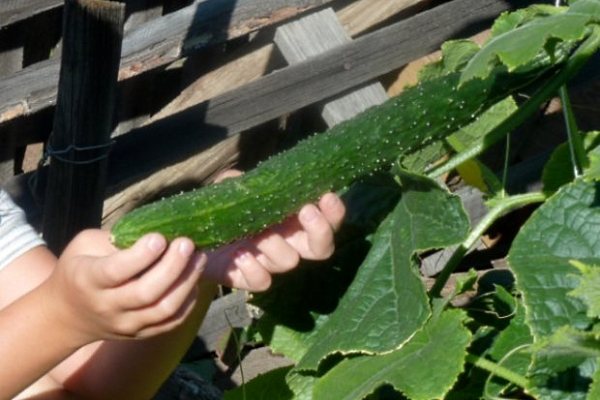

Cucumbers are perhaps the most popular garden crop in the world. Their demand encourages breeders to invent new improved varieties. These innovative varieties include the Emerald Stream cucumber variety., which fascinates with its name alone.
Brief information about the variety
- Fruit and bush: deep green cucumbers, weight - up to 250 g, length - up to 0.5 m; parthenocarpic hybrid.
- Yield: 1.5-2.5 kg per bush.
- Sustainability: has immunity to cladosporium disease, powdery mildew, frost-resistant, shade-tolerant.
- Spread: planting is possible in all regions of the country.
- Application: used for salads.
- Landing: the seed method is used only in the southern regions not earlier than April, in other regions - the seedling method; it is possible to land both in the greenhouse and in the open ground. Landing scheme - 50x30 cm.
- The soil: soil rich in phosphorus, potassium and nitrogen, light, with minimal texture, loose.
- Care: feeding the entire growing season every ten days, watering is moderate, in the growth phase - daily. The formation of a bush is performed by removing additional shoots.
- Ripening period: the crop bears fruit until late autumn, up to frost. The fruits are not suitable for long-term storage - they become lethargic and soft.
Description and characteristics of the variety Emerald Stream
This varietal variety is a popular early-maturing hybrid.
We owe his birth to the Moscow breeders I.N. Dubinina, S.V. Dubinin and A.N. Lukyanenko. This variety was included in the State Register of the Russian Federation in 2007.
Culture fit for cultivation both in the spring-summer period, and in the summer-autumn season.
The plant is resistant to summer heat, as well as spring and autumn coolness.The harvest begins to be harvested 40-45 days after planting the seeds.
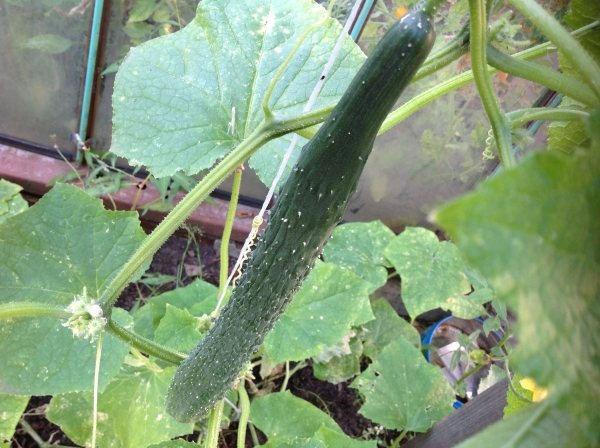

The variety is universal, can be grown in greenhouses and open field
The plant is very unpretentious in care, vigorous, requires a mandatory garter... For this, mesh, trellis and any other supports are suitable.
Leaves are rich green. On one bush, 4-5 fruits can form at the same time.
Cylindrical fruits, longare often curved. The tuberosity is average. In length, the fruits can reach up to 50 cm, but at the same time they are very thin and graceful. The largest fruits weigh up to 300 grams.
The peel is thin, rich green color, with barely noticeable whitish stripes. The taste of vegetables is excellent: the fruits are sweet and juicy, crispy and aromatic. Genetically, there is no bitterness in cucumbers.
Productivity is high... With normal care, up to 7 kg of ripe fruits are harvested from one square meter. Fruiting is very long, the plant actively bears fruit until the first frost and snow.
The taste of vegetables is excellent... It is best to use them fresh, in the form of salads. It is not only tasty, but also very convenient because one cucumber can be used to make a salad for the whole family.
The palatability of the fruit is in perfect harmony with lightly salted, salted, or pickled form. But large sizes do not always allow you to place cucumbers in jars, except by cutting them into several parts.
But in the form of salads rolled up in jars for the winter period, this variety is quite acceptable. Cucumbers will be juicy and crispy in any form.
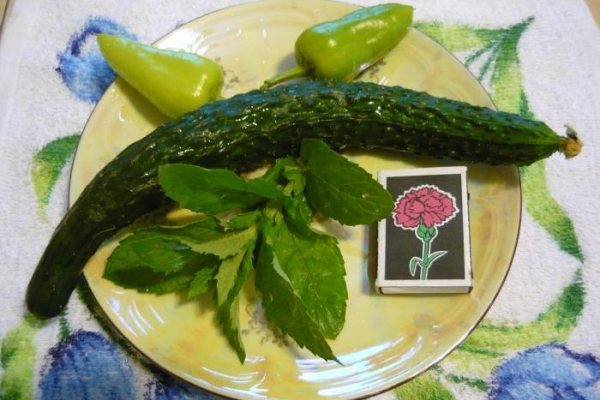

The variety is suitable for fresh consumption, as well as for salting
This culture high resistance to drought and temperature extremes is genetically inherent, as well as to various diseases, including downy mildew. This variety bears fruit well even in the shade.
Reviews of vegetable growers indicate that this variety is not to the taste of spider mites and aphids.
Even if there are other varieties of cucumbers growing in the vicinity of the Emerald Stream, which have been infested with aphids and ticks, our variety will be unaffected.
The most delicious are fruits up to 25 cm, they are very tender and sweet. Vegetables must not be allowed to overgrow more than 50 cm.
Otherwise, vegetables will begin to thicken, crack and turn yellow, significantly losing their taste.
Landing in open ground
Top dressing
The cultivation of cucumbers of this variety is carried out in two ways: both by seeds in open ground, and by seedlings. Vegetable growers recommend cultivating the plant in stages. The cucumber is picky about lighting, although it is classified as shade-tolerant. Lack of light will affect the color of the fruit and their taste.
Planting seeds of the Emerald Stream f1 variety into the ground should be carried out no earlier than April. The ground should be well warmed up; to increase the temperature, you can cover the bed with a film. The soil is loosened and 3-4 crops are planted on 1 m².
The seed is placed in holes no deeper than 3 cm. Gardeners suggest sowing 2-3 pieces in one hole. If all the seeds sprout, you need to choose a healthier and larger growth.
For seedlings
For the seedling method, it is advisable to choose the right pots and soil. For planting cucumbers, you can use the soil after nightshades or potatoes. With a reduced content of minerals in the soil, it is necessary to fertilize.
Before planting, the seeds are disinfected in a weak solution of potassium permanganate, and then placed in a solution of hydrogen peroxide to stimulate growth. After soaking, the planting material is immediately planted in prepared containers. If when selling on the packaging is about, then it is necessary to select the soil more carefully.
To prevent injuries in young plants during transplantation both in the greenhouse and in the open ground, it is better to plant seeds in peat pots.Plants are placed in the soil together with the container, after which the soil receives additional enrichment due to the decomposed peat.
If, after soaking, the seeds have dried, they usually begin to germinate. In order not to damage the sprouts, they are carefully (1 pc.) Laid in seedling pots.
Until emergence, the temperature is maintained up to 25 ° C. To create a greenhouse effect, the pots are covered with polyethylene. After the formation of the first leaves, the temperature for the seedlings drops to 19 ° C.
The only condition that must be met is sowing seeds in warm soil, that is, when the air temperature does not drop below 15 degrees. After the appearance of the first two leaves, thinning is carried out: weak plants are cut off, and not pulled out, and the soil between the remaining shoots is loosened.
When watering, water is poured between the rows so that it does not fall on the leaves and erode the roots. Loosening the soil regularly after watering will prevent a hard crust from forming. Form the plant using a net or other support.
Advantages and disadvantages of cucumber
This type has many advantages:
- High productivity.
- Excellent taste of the fruit.
- Long terms of fruiting.
- Resistance to various diseases and pests.
- Versatility in fruit growing.
- Long shelf life.
- Drought resistance and cold resistance.
But our variety also has its drawbacks:
- Possibility of root rot.
- The relatively large size of the fruit, which creates certain inconveniences when preserving.
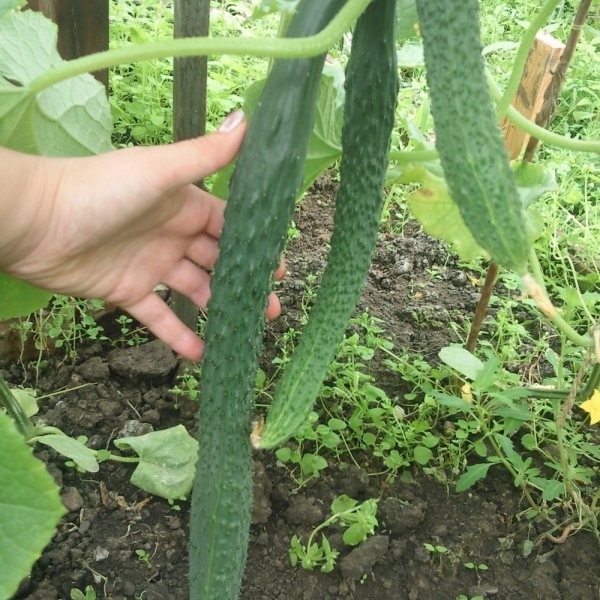

Advantages of the variety: high yield, long fruiting and storage periods
Growing features
There are two ways to grow our vegetable: seed and seedling... Experienced vegetable growers advise growing the crop in several stages, long fruiting periods will allow this to be done.
This can be done as early as March. The next step is to grow cucumbers in open soil.
Soil requirements
Plants are planted in open ground only after the end of night frosts. In this case, the soil should warm up to 15-18 degrees.
No matter how you grow, the soil must be breathable... The site for the future planting of cucumbers needs to be fertilized in the fall.
To do this, the soil is cleared of weeds and last year's plants, then any organic fertilizer is applied and only then dug up.
If it was not possible to feed the site in the fall, you can do this in the spring.
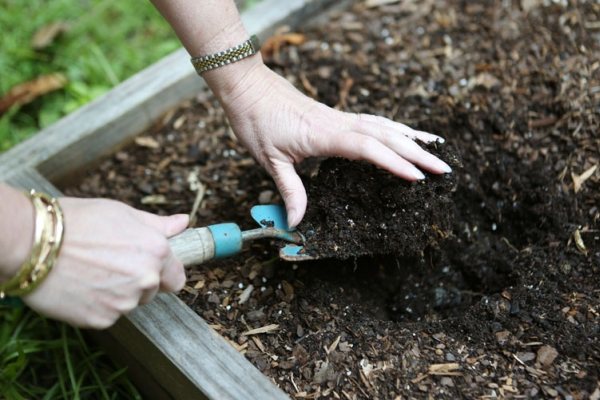

The site for the future planting of cucumbers needs to be fertilized in autumn or spring, dug up
Landing features
It is necessary to plant seeds in the soil after thoroughly loosening it. 3-4 plants are placed on one square meter.
The seeds are planted in the holes without deepening them by more than 3 cm. Experts recommend planting 2-3 seeds in each hole... If all sprout, then it is necessary to thin out the seedlings.
Planting through seedlings
This method of cultivating a crop is more laborious, but it allows you to get a good harvest even in regions with a northern climate. The seedlings themselves can be purchased or grown by hand. In any case, this issue needs to be given special attention, otherwise the sprouts may not take root in a new place.
Purchase of seedlings
To acquire strong seedlings for planting in a permanent place, you should use the following recommendations:
- Pay attention to the external characteristics of the specimens. At the age of 30 days, they should have a strong core and a uniformly colored dark green mass with 4-5 true leaves 15-18 cm in diameter.The optimum height of the sprouts is 20-25 cm. Such specimens are excellent for planting in a greenhouse already in mid-April.
- For planting in open ground or in a greenhouse, you can also purchase younger seedlings - at the age of 20 days. It should have a height of up to 16-18 cm, 2-3 true leaves with a diameter of up to 15 cm. In this case, planting work will need to be done in mid-May.
- For planting in the ground, you can choose very small seedlings - at the age of 10-12 days. They must have 1 real sheet. If they are transplanted to a permanent place at the end of May, then they will take root well and bring an early harvest.
- Refuse seedlings with elongated, thin and small leaves of a pale appearance, since they grew in violation of the cultivation technology.
- Examine the leaves from all sides for damage by aphids and other pests. If found, such seedlings are unsuitable.
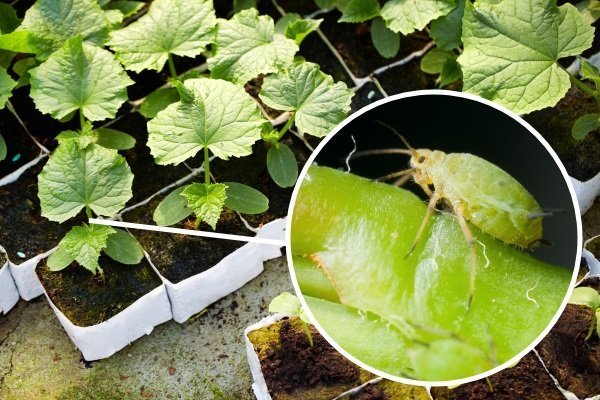

- Determine the state of the root system. It should be well developed, but at the same time it should not protrude massively through the holes in the containers. This will be a sign that the seedlings are much older than they seem, so it will be difficult for her to settle down in a new place. In addition, it is worth sniffing the container with roots. If an unpleasant odor emanates from it, it is possible that the shoots are affected by rot, so such seedlings should be discarded.
- Preference should be given to seedlings, which are sold in peat pots, since they can be immediately transplanted into the ground, without exposing sprouts with an immature root system to additional stress.
By purchasing seedlings of different ages, you can organize its phased planting in order to provide yourself with fresh cucumbers from the end of May until the autumn frosts.
DIY seedling preparation
Self-cultivation of cucumber seedlings can be divided into several stages, each of which determines the strength of future sprouts:
- Substrate preparation... You can buy it at a garden store or prepare it yourself, but in any case, it should be light, crumbly and nutritious. To prepare such a composition, you can mix:
- turf soil, sand, wood ash and rotted manure at the rate of 3: 1: 1: 1;
peat, humus and rotted sawdust at the rate of 2: 2: 1, and for 10 liters of this composition add 1 glass of wood ash and 1 tsp. urea, superphosphate and potassium sulfate.
Regardless of the selected composition, to improve its drainage properties and air permeability, you can add environmentally friendly materials like agroperlite, vermiculite, expanded clay or crushed foam. The finished composition must be watered with a weak solution of potassium permanganate or hydrogen peroxide (3 tablespoons per 10 liters of water) in order to disinfect it from pests and diseases.
Seedlings cannot be kept in pots for more than 30 days, since after this period it will be harder to endure various manipulations and will not be able to adapt to new living conditions.
Transplanting seedlings into the ground
When planting in a greenhouse, you do not need to take into account the atmospheric conditions, so you can only proceed from the maturity of the seedlings. If the cucumber is grown in the open field, planting work should be carried out after the end of the night frost. As a rule, this period falls on the second decade of May, when the air warms up to + 15 ... + 18 ° C, and the ground - up to + 12 ° C.
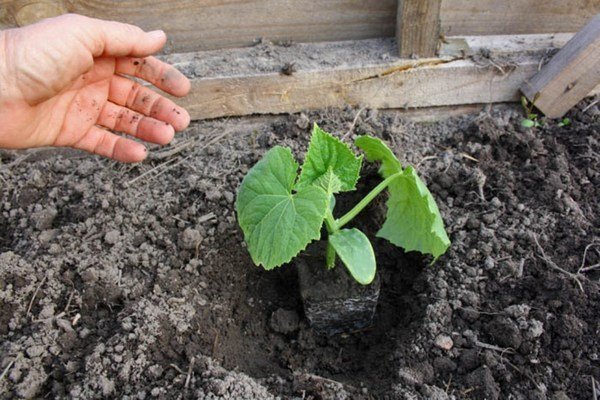

Transplanting seedlings is done in this order:
- Align the beds by forming rows with a taut cord.
- Prepare holes to the depth of peat cups or an earthen clod around the plant. Since the Emerald Stream belongs to medium-growing plants with large leaves, prepare the holes at a distance of 30-35 cm, and the rows at a distance of at least 50 cm.Thus, the planting pattern is 50x30 cm.
- Moisten the prepared wells and add hydrogen peroxide, if this has not been done in advance, at the rate of 0.8 liters for each hole.
- Plant pots or sprouts with an earthen lump in the ground so that their upper edges coincide with the edges of the holes, and then sprinkle them with earth.
- Water the crops abundantly with water at room temperature at the rate of 2 liters for each bush. To prevent the soil from drying out and protect it from weeds, mulch the bed using pine needles, sawdust or black agrofibre.
During the first 3-4 days after planting, the seedlings need to be watered abundantly, preferably in the evening, avoiding water getting on the leaves, as this can delay the development of the plant.
Plant care
You need to feed the plant throughout the growing season. Suitable for this slurry, urea solution, superphosphates.
Any kind of cucumber loves cleanliness. Therefore, the site must be regularly removed from weeds and loosened the soil.
Cucumbers are 90% water, therefore regular watering is vital for them... For our variety, watering should be plentiful, since the size of the fruits is impressive.
Water the plant in the evening with lukewarm water. But you must not allow excessive stagnation of water under the bushes. This is fraught with rotting of the root system.
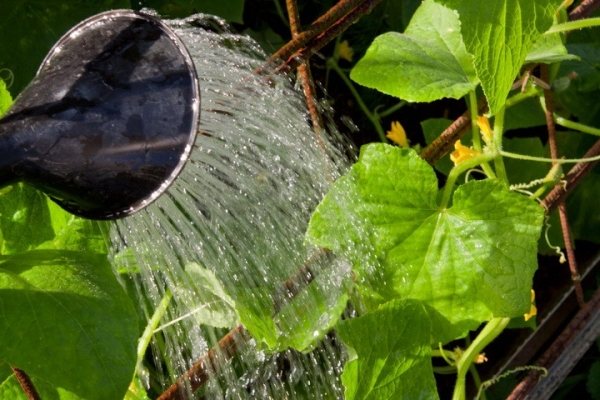

Watering should be regular and abundant, in the evening, with settled warm water
Diseases and pests
Emerald Stream is renowned for its high resistance to cladosporia, downy mildew and other common diseases.
In extremely rare cases the plant can infect aphids, or spider mites... You need to fight them with the help of special insecticides.
But here root rot, this kind of cucumber is very susceptible... To prevent this from happening, you should follow all the recommendations for watering and avoid stagnation of water under the bushes.
How to grow yourself
Hybrid Emerald Stream is versatile in cultivation and is suitable for planting in open ground, under film shelters, in greenhouses and even at home. Consider two main planting methods: seed and seedling.
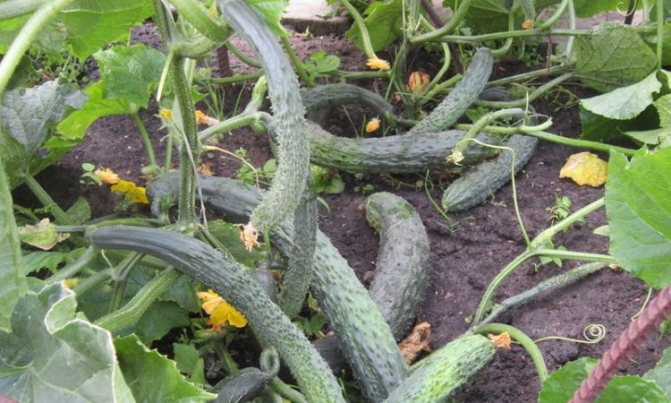

Planting by seed and seedling method
Vegetable growers recommend growing the Emerald Stream hybrid in a seedling way. But no matter which method you choose, the soil on the site should be loosened and saturated with nutrients. For better development of cucumbers, add potash, nitrogen and phosphorus fertilizers to it.
Attention: Fertilizers on the land for future cucumbers are applied in the fall. Clean the soil well from weeds and residues of other plants, apply any organic fertilizer. Then dig up. If it was not possible to feed the soil in the fall, do it in the spring.
Seeds are planted in open ground after night frosts have passed, so that the soil has time to warm up to + 15-18 ° C. Planting seeds in open ground is considered the most relevant method for the southern regions of Russia.
Seed planting process:
- Loosen the soil before planting seeds.
- Plant no more than four plants per square meter.
- Make holes in the ground 3 cm deep and put seeds in them, 2-3 pieces will be enough. If all the seedlings sprout, they are thinned out.
The seedling method is suitable for those who want to get a tasty harvest at the beginning of summer. Seeds for seedlings are sown in early March.
- Plant the seeds in peat bogs or individual plastic cups filled with prepared soil.
- Sprinkle lightly with soil on top and then water.
- Before the first sprouts appear, the cups are covered with foil and placed in a warm place.
- When the soil warms up to + 12 ° C, and the average daily air temperature reaches + 15 ° C, young plants are planted in open ground. By this time, they have 3-4 real leaves.
- Seedling planting scheme - 50x30 cm.
Attention: For seeds to grow and develop faster, treat them with potassium permanganate solution before planting, and then dry thoroughly.
Growing in stages and care
Cucumbers Emerald Stream needs regular and abundant watering with settled, warm water.
Important: Watering cucumbers is recommended in the morning or evening.
Plants need feeding throughout the growing season. Experts recommend using slurry, humus mixtures, urea solution and superphosphates as fertilizers.
Do not forget to look after: regularly weed the beds, get rid of weeds and clean the area - cucumbers love cleanliness more than other vegetable crops.
Features of cultivation and possible difficulties
The emerald stream is tied to vertical trellises and plants are formed. The central stem of the cucumber is pinched as soon as it reaches the top of the trellis.
Diseases and pests
Emerald Stream is highly resistant to cladosporium and downy mildew. The hybrid is rarely affected by aphids or spider mites. They fight them with folk remedies (onion or garlic tinctures) or with the help of special insecticides according to the instructions.
Emerald sweat is susceptible to such a disease as root rot. To avoid contamination, follow watering guidelines and avoid waterlogging the ground.

